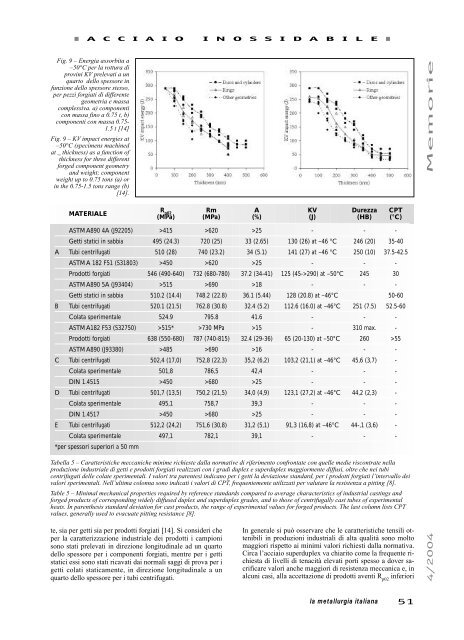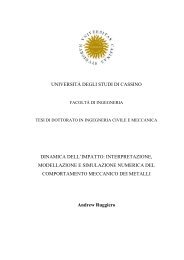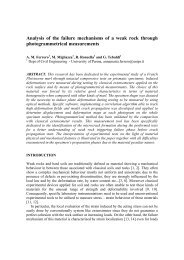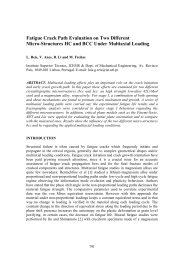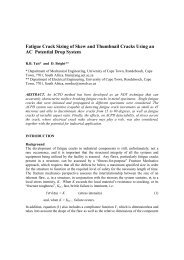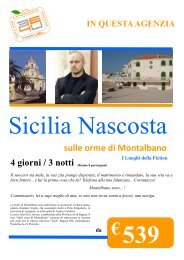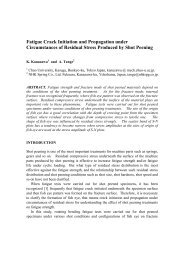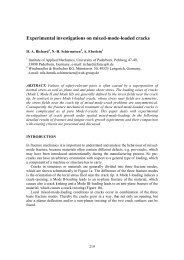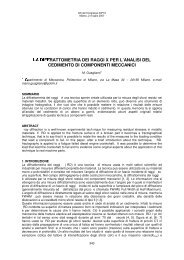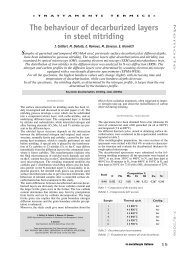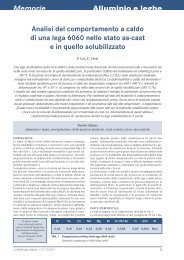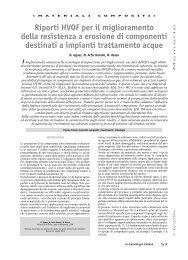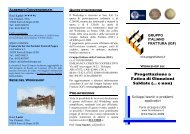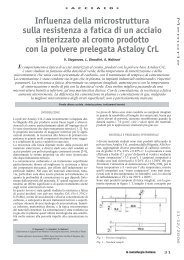Aspetti metallurgici e caratteristiche meccaniche in getti realizzati ...
Aspetti metallurgici e caratteristiche meccaniche in getti realizzati ...
Aspetti metallurgici e caratteristiche meccaniche in getti realizzati ...
You also want an ePaper? Increase the reach of your titles
YUMPU automatically turns print PDFs into web optimized ePapers that Google loves.
ACCIAIO INOSSIDABILE<br />
Fig. 9 – Energia assorbita a<br />
–50°C per la rottura di<br />
prov<strong>in</strong>i KV prelevati a un<br />
quarto dello spessore <strong>in</strong><br />
funzione dello spessore stesso,<br />
per pezzi forgiati di differente<br />
geometria e massa<br />
complessiva. a) componenti<br />
con massa f<strong>in</strong>o a 0.75 t, b)<br />
componenti con massa 0.75-<br />
1.5 t [14]<br />
Fig. 9 – KV impact energies at<br />
–50°C (specimens mach<strong>in</strong>ed<br />
at _ thickness) as a function of<br />
thickness for three different<br />
forged component geometry<br />
and weight; component<br />
weight up to 0.75 tons (a) or<br />
<strong>in</strong> the 0.75-1.5 tons range (b)<br />
[14].<br />
MATERIALE<br />
Tabella 5 – Caratteristiche <strong>meccaniche</strong> m<strong>in</strong>ime richieste dalla normative di riferimento confrontate con quelle medie riscontrate nella<br />
produzione <strong>in</strong>dustriale di <strong>getti</strong> e prodotti forgiati <strong>realizzati</strong> con i gradi duplex e superduplex maggiormente diffusi, oltre che nei tubi<br />
centrifugati delle colate sperimentali. I valori tra parentesi <strong>in</strong>dicano per i <strong>getti</strong> la deviazione standard, per i prodotti forgiati l’<strong>in</strong>tervallo dei<br />
valori sperimentali. Nell’ultima colonna sono <strong>in</strong>dicati i valori di CPT, frequentemente utilizzati per valutare la resistenza a pitt<strong>in</strong>g [8].<br />
Table 5 – M<strong>in</strong>imal mechanical properties required by reference standards compared to average characteristics of <strong>in</strong>dustrial cast<strong>in</strong>gs and<br />
forged products of correspond<strong>in</strong>g widely diffused duplex and superduplex grades, and to those of centrifugally cast tubes of experimental<br />
heats. In parenthesis standard deviation for cast products, the range of experimental values for forged products. The last column lists CPT<br />
values, generally used to evacuate pitt<strong>in</strong>g resistance [8].<br />
te, sia per <strong>getti</strong> sia per prodotti forgiati [14]. Si consideri che<br />
per la caratterizzazione <strong>in</strong>dustriale dei prodotti i campioni<br />
sono stati prelevati <strong>in</strong> direzione longitud<strong>in</strong>ale ad un quarto<br />
dello spessore per i componenti forgiati, mentre per i <strong>getti</strong><br />
statici essi sono stati ricavati dai normali saggi di prova per i<br />
<strong>getti</strong> colati staticamente, <strong>in</strong> direzione longitud<strong>in</strong>ale a un<br />
quarto dello spessore per i tubi centrifugati.<br />
R p02<br />
Rm A KV Durezza CPT<br />
(MPa) (MPa) (%) (J) (HB) (°C)<br />
ASTM A890 4A (J92205) >415 >620 >25 - - -<br />
Getti statici <strong>in</strong> sabbia 495 (24.3) 720 (25) 33 (2.65) 130 (26) at –46 °C 246 (20) 35-40<br />
A Tubi centrifugati 510 (28) 740 (23.2) 34 (5.1) 141 (27) at –46 °C 250 (10) 37.5-42.5<br />
ASTM A 182 F51 (S31803) >450 >620 >25 - - -<br />
Prodotti forgiati 546 (490-640) 732 (680-780) 37.2 (34-41) 125 (45->290) at –50°C 245 30<br />
ASTM A890 5A (J93404) >515 >690 >18 - - -<br />
Getti statici <strong>in</strong> sabbia 510.2 (14.4) 748.2 (22.8) 36.1 (5.44) 128 (20.8) at –46°C 50-60<br />
B Tubi centrifugati 520.1 (21.5) 762.8 (30.8) 32.4 (5.2) 112.6 (16.0) at –46°C 251 (7.5) 52.5-60<br />
Colata sperimentale 524.9 795.8 41.6 - - -<br />
ASTM A182 F53 (S32750) >515* >730 MPa >15 - 310 max. -<br />
Prodotti forgiati 638 (550-680) 787 (740-815) 32.4 (29-36) 65 (20-130) at –50°C 260 >55<br />
ASTM A890 (J93380) >485 >690 >16 - - -<br />
C Tubi centrifugati 502,4 (17,0) 752,8 (22,3) 35,2 (6,2) 103,2 (21,1) at –46°C 45,6 (3,7) -<br />
Colata sperimentale 501,8 786,5 42,4 - - -<br />
DIN 1.4515 >450 >680 >25 - - -<br />
D Tubi centrifugati 501,7 (13,5) 750,2 (21,5) 34,0 (4,9) 123,1 (27,2) at –46°C 44,2 (2,3) -<br />
Colata sperimentale 495,1 758,7 39,3 - - -<br />
DIN 1.4517 >450 >680 >25 - - -<br />
E Tubi centrifugati 512,2 (24,2) 751,6 (30,8) 31,2 (5,1) 91,3 (16,8) at –46°C 44-,1 (3,6) -<br />
Colata sperimentale 497,1 782,1 39,1 - - -<br />
*per spessori superiori a 50 mm<br />
In generale si può osservare che le <strong>caratteristiche</strong> tensili ottenibili<br />
<strong>in</strong> produzioni <strong>in</strong>dustriali di alta qualità sono molto<br />
maggiori rispetto ai m<strong>in</strong>imi valori richiesti dalla normativa.<br />
Circa l’acciaio superduplex va chiarito come la frequente richiesta<br />
di livelli di tenacità elevati porti spesso a dover sacrificare<br />
valori anche maggiori di resistenza meccanica e, <strong>in</strong><br />
alcuni casi, alla accettazione di prodotti aventi R p02<br />
<strong>in</strong>feriori<br />
4/2004 Memorie<br />
la metallurgia italiana 51


